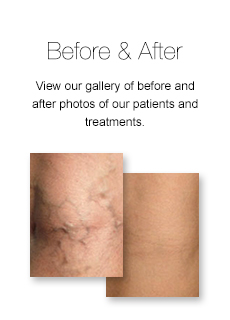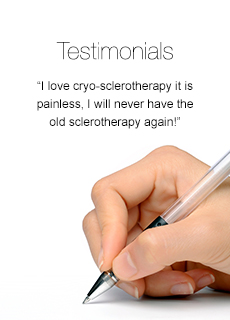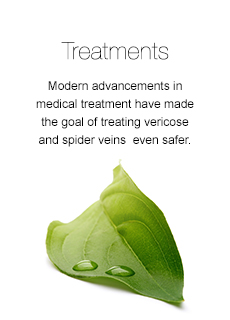Dr. Navarro has retired and now refers patients to his protégé Dr. Al-Misky. Click here for details.
212-888-8688 | 800-300-VEIN | 212-249-6117
910 Fifth Avenue (cross street: 72nd) New York, NY 10021
Frequently Asked Questions
Varicose veins are caused by a failure of the valve of the vein or of the walls of the vein. Blood in the vein accumulates in the lower part of the body, the pressure of the blood in these veins increases, and the veins begin to bulge out of the skin.
Varicose veins are rope-y, tortuous veins that you see on many women, often on the legs. They are often a greenish or bluish color and can bulge out from the surface of the rest of the skin.
Varicose vein symptoms often include discomfort of the legs, heaviness, discoloration (often an ash-y hue), and sometimes progressing to sharper pain as time progresses. When the pain is more severe, the ankle often swells, there are some changes to the skin (often darkening), and eventually the skin could ulcerate.
Unfortunately it is quite difficult to avoid spider veins. Much of the drivers of developing spider veins is either genetic or due to common life events (carrying children in utero, etc). Avoiding birth control hormones and other female hormones could help. Luckily, treatments for spider veins is straightforward - if you can find a specialist soon after developing spider veins, they can usually be eradicated in a couple of visits. They will usually not reappear for two, three, or more years afterwards.
To diagnose spider veins, Dr. Al-Misky first does a physical exam on the patient. Then she will do a Doppler ultrasound to determine exactly where the faulty valve in the vein network lies. The Doppler ultrasound clearly shows the direction of blood flow in the veins; without a Doppler US, it’s very difficult to tell if the faulty valves causing spider veins are superficial or in the deeper perforator veins going through muscle and other tissue. Dr. Al-Misky does all of her ultrasounds herself to ensure that the root cause of patient’s spider veins can be addressed immediately.
Unlike varicose veins, spider veins have minimal symptoms for most patients. Most patients don’t have pain or swelling, though a few express feelings of itchiness or slight ashiness in the affected area. By far the biggest complaint patients have is with the appearance of the spider veins- unfortunately, they can be conspicuous.
A patient with long-standing varicose veins can develop swelling at the ankle and lower part of the leg. At the onset of swelling, the edema can disappear at night. Over time, it can become chronic, with the pressure of the swelling stressing the skin and causing pigmentation changes such as brown spots on the lower leg. If not treated, this swelling can eventually cause the skin to break down and ulcerate.
EVLT is a very reliable modality for fixing varicose veins, but in perhaps 2% of cases it fails to close the vein properly. The procedure can then be repeated a few days later to ensure that it closes properly; this would be done at no additional expense to the patient.
We usually advise pregnant patients to wait until after they have delivered to seek vein treatment, unless there is an emergency (usually due to the location of the vein). Varicose veins can change quickly in the last months of pregnancy. We have found that waiting until six weeks after delivery provides the best results - some veins that became engorged during pregnancy may return to normal size and do not require treatment, while others will remain prominent and will need treatment.
The Endovenous Laser Ablation treatment is a relatively comfortable procedure. EVLT is done under local anesthesia. The patient will be awake and can be listening to music on earphones or watching a movie on an iPad. The patient should feel no discomfort during the procedure; if for some reason they are uncomfortable, they can tell Dr Al-Misky or her nurse and they can adjust accordingly.
During recovery in the days following surgery, there is often mild discomfort that can usually be taken care of by over the counter NSAIDs.
The largest determinant in whether a person will get spider veins or varicose veins is whether they have a congenital predisposition to them. If a person’s had spider veins, that person is more likely to have them as well. Other things that can increase the chance of getting spider and varicose veins are pregnancies and taking hormones.
The mechanical cause of spider and varicose veins is that there is a failure of the valve of the vein or of the walls of the vein. An accumulation of venous blood occurs and becomes visible through the surface of the skin.
Aging, weather, and sun exposure can give hands a leathery feel and make hand veins more pronounced. Dr. Al-Misky can easily and effectively treat dilated hand veins with sclerotherapy. (see Hand Veins)
We cannot treat your genetic predisposition to develop varicose or spider veins, so new veins may reappear in the same area or in other areas. Usually a touch-up treatment to remove new veins will be needed every 1-3 years.
Absolutely! While women experience vein problems more frequently, men with vein problems are more likely to suffer from the discomfort of large dysfunctional veins. Men usually have very good results from Endovenous Laser Treatment.
Yes, unfortunately spider veins can reappear. The routing of blood through the venous system is a dynamic process; when sclerotherapy eradicates spider veins, the blood that these veins used to carry gets rerouted to other healthy veins. These healthy veins may eventually develop faulty valves and new spider veins can form.
Often it takes years for the new spider veins to reappear. Rarely, it can happen within a few months. Either way, we can handle them and get dramatic improvements.
Yes, some people are congenitally predisposed to getting varicose veins and spider veins. It often runs in their families, with the mother’s side of the family having a stronger impact than the father’s side.
No, the good news is that it is almost impossible for varicose veins to be fatal. Varicose veins are a disease that progresses very slowly- it usually takes years between the first presentation of venous insufficiency to become unsightly. After 10, 15, or 20 years, the condition can develop to the point of causing complications with ankle swelling, skin changes, cellulitis, and eventually ulceration. Ulcerated veins could conceivably become infected, but with proper treatment people should never reach this state.
Many different types of doctors treat varicose veins, but there is a wide variety of skill between practitioners. Patients would be best served by an MD who specializes in varicose vein treatment. Some vascular surgeons do varicose vein procedures; their time is also often spent doing a range of other procedures such as angioplasties, stenting of arteries and veins, and bypass surgery for artery blockages as well as treating varicose veins. The practitioners who usually have the most dedicated experience in treating varicose veins are doctors who are Diplomates of the American Board of Venous and Lymphatic Medicine- their main interest is in treating varicose and spider veins. Dr. Al-Misky has been a Diplomate since 2009 and has been specializing in venous symptoms since 2001.
Patients who have varicose veins have about 60% to 80% chance of having spider veins as well. Both varicose veins and spider veins have the same root cause- faulty valves in the veins. We usually treat the varicose veins first as they are the larger problem, then we can treat the spider veins on subsequent visits to continue to improve the cosmetic appearance with each visit.
Two possible side effects of oral contraceptives and hormone replacement therapy for women is the weakening of the walls of the veins, and the opening of shunts (microscopic channels between the arteries and the veins). These changes can cause the venous blood pressure to increase, leading to the valves in the veins to fail. The dysfunctional valves cause the pooling of blood that causes varicose veins and spider veins.
Spider veins are tiny veins, usually 1mm to 2mm in diameter, that can appear conspicuously on the skin surface as they are often blue, purple, or red in color. They are often found on the thighs, back of the knee, or on the back of the calf when on the leg, but can be found on other body parts as well. The shape of the presentation of these veins can vary, but it is often in the form of a spider, hence the term ‘spider vein’
The gold standard treatment is sclerotherapy- it is both the most effective in eradicating the spider veins and the results last as long as possible. In sclerotherapy, a solution is injected into the vein through very thin gauge needles. The solution irritates the inner lining of the delicate spider vein and the vein closes upon itself.
There is another technique that involves lasering the spider vein through the skin. Dr Al-Misky used this technique for several years but found that sclerotherapy, in the hands of a very skilled practitioner, can get better results for almost all spider veins.
Sclerotherapy therapy is usually not painful. We use extremely thin gauge needles- a patient can usually feel the prick of the needle entering the skin but it should be akin to the feeling of a mosquito bite (obviously without the itchiness later). Every patient has their own pain tolerance; patients who are extra-sensitive should tell us that when making the appointment as we can help ensure their comfort in a few ways. If the patient comes in half an hour ahead of their treatment, we can apply a cream to numb the skin. We could put cold air on the skin during treatment (this helps numb the sensation but also makes it a bit tougher to inject the veins). We could use a distracting vibration at another part of the body to mask the feeling of the needle’s entry.
Endovenous Laser Treatment works well on larger veins, but for smaller veins (such as those causing spider veins), Dr. Al-Misky has found that sclerotherapy is by far the most effective way of treating them. EVLT and sclerotherapy can be done in a combination therapy if there are both larger varicose veins and smaller spider veins.
Yes. Many women worry that they have visible veins that negatively affect the appearance of their breasts. We have extensive experience performing sclerotherapy treatments on the breast. A number of women tend to develop visible breast veins after breast augmentation surgery. If deemed unsightly, all breast veins can easily be treated with sclerotherapy (See Breast Veins).
For varicose veins, one surgery per area (usually leg) is often enough to address the problem.
Treating spider veins, however, is often an iterative process- the veins that are treated in one sessions disappear after a few weeks and Dr. Al-Misky can focus on the spider veins that remain. The patient can decide with Dr. Al-Misky what level of cosmetic perfection is desired- the higher level of improvement, the more sessions will be required.
Varicose veins will often be eradicated after the first treatment. The bulging veins are often gone the day of the procedure, and the patient can go about daily living. A bit of discomfort (which can usually be addressed with OTC Tylenol) will persist for up to a week. The day after the treatment, Dr Al-Misky will have a follow-up with the patient. If there are spider veins, they can be treated at the same time as the follow-up. For best cosmetic results, subsequent treatment of spider veins may be necessary to complete the cosmetic improvement process. The bruising from the surgery and follow-on spider vein treatments are often resolved within 3 to 4 weeks of the varicose vein treatment.
Patients can schedule treatments to suit their schedule. Some patients schedule their appointments a month apart, some a week apart, and some have an intensive schedule where they will see Dr. Al-Misky several times in the same week. Out-of-town visitors can particularly benefit from an intensive schedule. When possible, we’d encourage patients to address their veins within a few months; varicose veins and spider veins are progressive diseases and any outstanding veins can become more prominent if a significant amount of time passes.
Whether insurance will reimburse for vein treatment depends primarily on which type of insurance the patient has and what procedure is being done. In broad strokes: insurance companies are more likely to pay for procedures that they deem to be medically necessary than procedures considered cosmetic. Insurance may pay for a varicose vein procedure that is for treatment of a vein of a certain size, and that has vein reflux & a faulty valve that can be documented by a Doppler ultrasound. Endovenous laser therapy and mini-phlebectomy surgeries are often covered by insurance. Most insurance companies are less likely to cover sclerotherapy as it is considered primarily cosmetic. That said, some insurance companies will cover sclerotherapy done soon after an EVLT or mini-phlebectomy procedure as part of the whole treatment plan.
Varicose veins and spider veins are progressive conditions. Without treatment, their cumulative nature will make current vein problems worse and increase the likelihood that new vein problems will develop. Consequently, patients are encouraged to seek treatment early. Likewise, we encourage patients to plan ahead for their treatment, as many modalities require multiple sessions to achieve desired results. The sooner we are able to treat the problem veins, the better the results, the fewer complications, and the faster you will heal from the procedure.



